When we first started planning our Japan trip, before we knew more than it would start with a flight to Tokyo and feature a cruise around Japan, I knew I wanted to do one thing…. Climb mount Fuji. Those who have read Robyn’s other posts will know Fuji features in my favourite piece of art, looming large of a frantic sea that is the “Great Wave” and as far as I was concerned – Fuji IS Japan! I spent months researching and preparing. I enlisted two willing travel companions, trained with practice walks, did my research on the best ascent routes, learnt how to tackle the mountain and what to expect and gathered the necessary gear for what to expect on the mountain. Wary that i was tied to two specific climbing days and needed to bring all the gear with us we travelled as light as possible. In hindsight, I am now aware that I had too little and that all the information I found in my research on the internet was out of date and did not fully prepare me for the full adventure we were undertaking.
This epic journey to the summit of mount Fuji started out with what I expected to be the easiest part, little did I appreciate the arduous task of just getting to the start of our walk. We began at the largest train station in the world – Shinjuku Station. 3.5 million people go through there every day, that is the entire population of Australia by the end of the week!
I erred by assuming that there would be a clear sign taking us to the bus station, we followed the only bus signs at the train station. These signs eventually emptied us out at the exact opposite end of the bus station that we needed. With only thirty minutes to go before our bus left and no idea of where to go I asked a nearby police officer for directions. Thankfully even with his limited English he offered clear directions and informed us that our bus was only 10 min walk – under the train station and around a shopping area. After some searching we eventually made it to the right spot which was nestled off the street and behind some buildings in a back alley not visible as a bus station until you are right on top of it. We made it with barely a few minutes to spare and having not yet purchased our water supplies, any snacks and had NO TIME to find an ATM.
SaucyMary went looking for water, while I stood in line to collect our prepaid tickets. She picked up 4 x 2L bottles, which while a bit big too fit in our packs, we ended up really needing. I had no luck finding an ATM, but I assumed there would be places where I could obtain cash amongst the shops and restaurants at Step 5 – the Fujiyama line, beginning of our chosen climbing route up the mountain (and the largest). The bus ride was filled with nervous excitement as all thirty travellers chatted in groups. It had been raining all week and while the weather had not cleared, no one was certain on what we would expect on the mountain which added to our collective nerves. The two and a half hour bus ride was uneventful enough taking us south of Tokyo through some rural areas and small towns towards the mountain.
We had a great view of life outside of Tokyo city… Amongst the signs of normal life were increasing numbers of rural plots, beautiful scenery with steep forested hills before a road tunnel would remove this view and the landscape on the other side would magically give way to small cities where hydroelectric pipes forge down the sides of the steepest hills and across train lines into small scale civilisation. The passing scenery was lovely but we were all seeking out the windows for the first sight of Fuji.
The transport worker in me marvelled at the bus route itself and noted the five different locations we pulling over on the elevated highway to pick up more passengers – unheard of at home, buses on highways do not stop, and what puzzled me was how these people ended up at these bus stops, stops where there didn’t appear to be any pedestrian access?!
The first sign marking our arrival near the national park was not a glimpse of the mountain, rather the sight of the giant Fujiyama Theme Park. The theme park has five of the largest rollercoasters in the world and at one time had THE largest and fastest rollercoaster in the world and it sits proudly at the base heralding our arrival. There was no activity in the park and as we couldn’t see anything for the fog, mist and clouds the bus full of passengers chatted away in hushed tones announcing our arrival to their travel companions. The bus entered the National Park/World Heritage Park and started ascending the mountain – starting at Step 1, the bus travelled slowly to Step 5 which is at 2,300m elevation. This part of the mountain is covered in thick forest and heavy vegetation and the mist added an other worldly air to the surrounds. The view removed any wonder at how this site had become sacred to the Jaapanese. It had finally stopped raining at this point, but the humidity was 100% so actual visibility into the forest areas was limited – about 40m in front of you at best meaning no sign of the top of the mountain
The bus parking leading into Step 5 surprised me at how massive it was – starting more than 500m away from the actual Step 5 Station unused this early in the climbing season. There was evidently enough parking for hundreds of buses which would make for a ridiculous climb with that many people. We got off our bus right near the Station and found four shops and a national parks information stand. It was ¥1000 per visitor to enter the park, and there was easily 500 people milling around this area. Most of them appeared to be Chinese and they were busying buying souvenirs and sending postcards. We bought the traditional pilgrims pole (walking stick) that is used to collect brands/stamps of the various stations as you progress up the mountain and placed some spare clothes in a locker for our return.
It was at this point that I discovered there were NO ATMS on the mountain. Fuck. No one takes credit up the mountain and we had limited cash. Which was quite the dilemma as we needed cash to pay for toilets at ¥200-¥300 each time you wanted to pee (that’s $3.30 per person to empty your bladder!), stamps for our walking sticks, food, water and any other needs. I had to borrow money back from the Small Child once I realised how little cash I had, but thankfully SaucyMary had some cash on her too… turned out to be barely enough to get us through. I highly recommend that anyone doing this hike, calculate how much cash you think you need to take – and then double it! I negotiated with one of the shops to accept my Visa to buy some lunch for all of us, and we all carb-loaded on curry rice and dumplings.
Having spent two hours attempting to find a way to acquire cash and have lunch, we had well acclimated to the elevation of Step 5 as we set off. Interesting to note – the first kilometre of the trek is fucking downhill! How bloody counterintuitive is that?! Thankfully SaucyMary had read the signs and was able to assure us that, yes, we were still on the right walking track and heading in the correct direction.
 We started off at 2pm, much later than planned, and while we had full tummies we were walking through a cold, fine mist of fog. At some point the track splits out for different hikes, and we saw the first sign to the Fuji summit and began climbing back up. We were still in a semi-forested area, where new trees were growing out of the ground and then appeared to be growing straight sideways. There was lots of water on the ground, so the track was wet, as it had been raining for weeks apparently.
We started off at 2pm, much later than planned, and while we had full tummies we were walking through a cold, fine mist of fog. At some point the track splits out for different hikes, and we saw the first sign to the Fuji summit and began climbing back up. We were still in a semi-forested area, where new trees were growing out of the ground and then appeared to be growing straight sideways. There was lots of water on the ground, so the track was wet, as it had been raining for weeks apparently.
 It was around this point that we met our first hikers heading back down. We said our ‘hellos’ but were unable to get any useful information from them. :/ Not long after them, we encountered a group of crazy bastards – they were running. There was about fifteen of them all up and they were running down the mountain. What’s with that? Did they run up too? We have no idea.
It was around this point that we met our first hikers heading back down. We said our ‘hellos’ but were unable to get any useful information from them. :/ Not long after them, we encountered a group of crazy bastards – they were running. There was about fifteen of them all up and they were running down the mountain. What’s with that? Did they run up too? We have no idea.
The walk so far had been fairly easy. The tracks were wide and graded, and we reached Step 6 really quickly. There is a little information hut at Step 6 where they told us, if we wanted a stamp on our poles, we actually had to go down the mountain on another track (there is an alternate route to this point) – and even though we’d had it pretty easy going at this point, no one wanted to be backtracking. So much for collecting all the stamps on our poles. Visibility was still quite low, and we were unable to see more than 100m in any direction. We were comfortable, but we had no idea where we were going – you could not see the mountain stretching some way up beside us but we could not see Step 7 or step 8 where we would spend the night. The terrain had changed immediately after step 6 from vegetation to mostly volcanic rock… small crumbly red rocks that was compacted like crusher dust, so it was effectively like walking on concrete with the paths protected by large landslide barriers to keep the path intact. It was not far out of Step 6, about the tenth zigzag in the trail, that we started to need to take short breaks to regain our breath (elevation approx: XXX). Given that we live at sea level and were unused to the lighter oxygen it was getting more difficult to breath.


 At one of these break stops, the weather started to clear and we could finally see Step 7 ahead of us, which had all these little huts all the way up to Step 7 and beyond. We could see there was snow still on the mountain, and importantly, we could see large rocks that we were going to have to clamber over. So it wasn’t until this point in our hike that we could feel that we were climbing the mountain – prior to this it just felt like we just walking to no where. Up. Just up.
At one of these break stops, the weather started to clear and we could finally see Step 7 ahead of us, which had all these little huts all the way up to Step 7 and beyond. We could see there was snow still on the mountain, and importantly, we could see large rocks that we were going to have to clamber over. So it wasn’t until this point in our hike that we could feel that we were climbing the mountain – prior to this it just felt like we just walking to no where. Up. Just up.

 We started to strike up some conversations with some of our fellow hikers – we met a group of about ten Americans who had been up the mountain before, but only to Step 7, but they had to come back down to catch their bus back on their previous climb and this time had worked out the logistics to make it all the way to the top. They were staying at the same lodge/mountain hut that we were – Fujisan Hotel at Step 8.
We started to strike up some conversations with some of our fellow hikers – we met a group of about ten Americans who had been up the mountain before, but only to Step 7, but they had to come back down to catch their bus back on their previous climb and this time had worked out the logistics to make it all the way to the top. They were staying at the same lodge/mountain hut that we were – Fujisan Hotel at Step 8.
We reached the first of the Step 7 huts, and each was a tiny little shop where they would burn a brand into your pole, and they provided mats on the floor if you wanted to take a break out of the weather. Most had toilets… all of which was available to for a CASH fee (goddamn our lack of forethought on the cash front). We collected a few brands here and they cost ¥300 each (again about AU$3.30). At this point we pooled resources, after paying for expensive toilets and a locker at Step 5 (to hold some clean dry clothes for the ride home), I had only ¥2000 left and SaucyMary only about ¥4000. Grrr.
It was at this point that we and our American counterparts discovered that we had wrongly assumed that what we could see in front of us stretched up the mountain were the Step 8 huts, including the Fujisan Hotel. From where we were – as the huts seemed to stretch out in front of us… unfortunately all the ones we could see were still Step 7, and our Step 8 hotel was much further and more difficult to reach than we anticipated.
 We collected some more stamps along the way, though perhaps not as many as we would have if we had brought more cash! The weather started to turn bad as we passed the third of the Step 7 huts. Rain, and proper rain this time. And the terrain between the huts was becoming more vertical – we were clambering over wet rocks and navigating through tour groups of school children and many elderly climbers waving their sticks around. We had to stop and readjust out clothing to cater for the rain… which is where I accidentally left my favourite purple polo shirt when I changed into something dry and warmer. A lot of the school kids were staying at Step 7 so the traffic thinned out after this – which was about 3000m elevation. We encountered our first signs for step eight indicating that there was an another hour and a half climbing and so we had to keep on going.
We collected some more stamps along the way, though perhaps not as many as we would have if we had brought more cash! The weather started to turn bad as we passed the third of the Step 7 huts. Rain, and proper rain this time. And the terrain between the huts was becoming more vertical – we were clambering over wet rocks and navigating through tour groups of school children and many elderly climbers waving their sticks around. We had to stop and readjust out clothing to cater for the rain… which is where I accidentally left my favourite purple polo shirt when I changed into something dry and warmer. A lot of the school kids were staying at Step 7 so the traffic thinned out after this – which was about 3000m elevation. We encountered our first signs for step eight indicating that there was an another hour and a half climbing and so we had to keep on going.

From this point on, it would change between wide paths that we zigzagged up the mountain on about an 8-10° incline, and then straight up scrambling over rocks. The altitude was starting to really effect me at this point – SaucyMary was going on ahead and the Small Child seemed to be holding up well… so far. We could finally see Step 8 which still seemed a daunting distance away given it was such arduous terrain to cover, especially in the wet. One of the Americans was coming back down towards us about 15 mins shy of Step 8. He was heading back to Step 7, one of their party had injured her ankle and he was turning back to help her before dark – I can’t imagine how he felt, I was exhausted and was just about ready to turn around and go back… I didn’t have the energy to keep going beyond the next fifteen minutes and was unsure if I was going to be able to make it at all – and here he was, going back to help his friend.
 Eventually we made it to our Fujisan Hotel at Step 8, at about 8pm – six hours after we left Step 5 (a 3 hour walk). We discovered it definitely wasn’t the Waldorf! LOL. Not that we were expecting luxury, but this was really rudimentary. There was six tables and benches for people to use. Fifteen of us there all taking off our wet clothes, that the owners were forcing us to put in plastic bags – when what we really wanted to do was hang them out in the hope they would dry a bit overnight. We ate our really simple meal, that was included with our ¥8500 per person accommodation – a bit of vegetarian curry rice with a rissole thing on the side and two cheerio sausages, of all things! So there we are, exhausted, soaking wet, worried about whether we can get our clothes dry, and encountering severe language difficulties to pay for our booking as the hut owners spoke no English whatsoever. No English – but they’re the only damn people on the mountain who take credit cards. Like many of these types of things the world over – there was one old guy there whose job it was to take everyone’s money, while the rest of six staff were run off their feet cooking and settling everyone in.
Eventually we made it to our Fujisan Hotel at Step 8, at about 8pm – six hours after we left Step 5 (a 3 hour walk). We discovered it definitely wasn’t the Waldorf! LOL. Not that we were expecting luxury, but this was really rudimentary. There was six tables and benches for people to use. Fifteen of us there all taking off our wet clothes, that the owners were forcing us to put in plastic bags – when what we really wanted to do was hang them out in the hope they would dry a bit overnight. We ate our really simple meal, that was included with our ¥8500 per person accommodation – a bit of vegetarian curry rice with a rissole thing on the side and two cheerio sausages, of all things! So there we are, exhausted, soaking wet, worried about whether we can get our clothes dry, and encountering severe language difficulties to pay for our booking as the hut owners spoke no English whatsoever. No English – but they’re the only damn people on the mountain who take credit cards. Like many of these types of things the world over – there was one old guy there whose job it was to take everyone’s money, while the rest of six staff were run off their feet cooking and settling everyone in.

We were rushed through our meals, and then for reasons unknown, we were being pushed upstairs to go to bed? No idea why, the staff all appeared to be awake all night anyway, so it’s not like their shifts were ending. Once we had eaten, we were escorted upstairs with our plastic bags full of wet clothes and shown to our bunks (NB: generous to call it a bunk). It was a sleeping bag and blanket of dubious cleanliness, a mat each of about 70cm in width, crammed in with our neighbours, and a hook above each ‘bunk’ to hang your bag. We were literally laying shoulder to shoulder, with sleeping space for about 120 and it was full.
I didn’t sleep more than about an hour and a half to two hours over the six we were there- there was a lot of noise, lights were left on, some bloody loud snorers, the Small Child was complaining of a sore tummy, the bedding was sandy (the sleeping sheet that I had read would be provided never materialised) and it was hot and stuffy and due to the elevation, very hard to breathe. In hindsight, it is possible this room full of weary hikers was not very well ventilated and we may well have been breathing in a lot of carbon dioxide all night… not optimal for hitting the trail again in the morning. I spent the night labouring with my breathing and listening to the Small Child breathing hard too… and I was feeling anxious about the hour of hard climb we had left to do to get to the summit.
I got up twice to go to the toilet and was supposed to pay ¥200 each time but stuffed if I was going to pay ¥8500 per person to stay there for the night and then shell out more to use the loo. There was actually a coin operated turnstile to go to the toilet… screw that, I jumped it, and with some encouraging, so did the Small Child – though he felt bad about ‘doing the wrong thing’ but bugger this for a joke, I didn’t! After a fitful six hours, people started to be woken around 2am, even though our wake up time was scheduled for 2:30am, it was impossible to ignore everyone getting ready to leave the hut for the final hour of the hike. I was very thankful we had climbed so far the day before and that we hadn’t stayed at a lower hut and were not faced with a harder climb to be done.
We all put on our wet clothes, and plastic bags over our socks to keep our feet dry under our wet shoes and it was still lightly raining outside. It looked threatening and like it would start raining heavily again at any moment. The Small Child was still complaining of a sore stomach and I was muscle sore from the day before and both of us having trouble breathing, and we sat in silence for about five minutes – I was internally debating if we should even go onwards or wait for sunrise and see what the weather was doing… the whole idea of this overnight endeavour was to see the sunrise, so…? We looked outside and could see the lights going up the trail, and we had markers to indicate how much further it was, but they didn’t seem to be a good indicator prior to this point. We could still not see the summit or beyond another three hundred meters up the mountain.

The final decision was made – we were going to head out and try to see the sunrise. We made our way for Step 8.5. Which was listed as 30 minutes climb and by the looks of the lights ahead of us, was almost straight up. It didn’t look good, and given our sea level fitness, I decided to buy a small bottle of oxygen largely because I was worried about how our already laboured breathing sounded.



 Going through this 30 minutes was almost as difficult as the last hour of the previous days climb. We would move forward a dozen steps and need to rest. I could feel the heaviness of the altitude on my chest, and the Small Child was stopping, to sit, his head in his hands, with a sore stomach and breathing with difficulty. I couldn’t convince him to eat anything as he was worried about throwing it up, so no doubt he was low on blood sugar too – not ideal. So much for the 30 mins, it took us a full hour to complete this section because of our constant need to rest.
Going through this 30 minutes was almost as difficult as the last hour of the previous days climb. We would move forward a dozen steps and need to rest. I could feel the heaviness of the altitude on my chest, and the Small Child was stopping, to sit, his head in his hands, with a sore stomach and breathing with difficulty. I couldn’t convince him to eat anything as he was worried about throwing it up, so no doubt he was low on blood sugar too – not ideal. So much for the 30 mins, it took us a full hour to complete this section because of our constant need to rest.
it was as we left step 8.5 that I noticed a woman travelling near us who was clearly suffering from altitude sickness, she was alone, she was well equipped, but was throwing up, sweating and dishevelled. We were all showing some symptoms of the effects of the altitude, but none of us were suffering as badly as she was. Luckily for her other travellers regularly stopped to help her and offer assistance. Both the small child and I felt terrible but were clearly not suffering as badly as others on the climb.
After Step 8.5, we had only another 30 minutes to the Summit. But again, it was straight up and over rocky terrain. This final section took well over an hour. The sun rise occurred as we were about 150m from the summit. We did not miss our sunrise moment as even if we were at the summit, rain and mist had given way to cloud and patchy light making it a moot point.

You would think that only 150m could be covered quickly but not on that track and not at that altitude. We saw a red sliver in the east and the gloom lifted somewhat so we were able to turn off our head lamps. Saucy Mary went on ahead, as the Small Child and I were going quite slow to accommodate his feeling unwell. He was really struggling. We must have stopped every five steps. I gave him little goals, ‘Let’s make it to where those people are and we can have some oxygen’… It was around this point that Angel had what I guess was a panic attack. He felt he couldn’t’ breathe, he was agitated, and lacking in oxygen, he was so desperate, he went DOWN about five meters back to a rock he had been sitting on before as he knew it was a comfortable place to stop. We rested there for about ten minutes, and he had some oxygen. I managed to get him to have some Kit Kat at this point, which was much needed and thankfully he managed to keep it down. He felt a little bit better and we continued our climb.
Five meters. Stopping. Five meters. Stopping. Until we were about 75m from the top. Throughout this last section, we could hear people cheering upon reaching the Summit… and at this point, the clouds seemed to lift and we could finally see the Summit. The goal was finally in view. Up until this point, we were trudging, seemingly endlessly towards an ethereal unseen goal. With only 50m to go, the rocky unforgiving terrain changed to civilized stairs. With the promise of hot chocolate at the Summit, the Small Child rallied considerably and started to bound ahead with renewed vigour. I myself was struggling really badly still. Angel was nice enough to wait for me though, and we passed under the torii gate, signalling the end of our climb, arm in arm.
Both smiling knowing that the ascent was over, knowing that we had made it, when both of us were really not sure that we would… in fact at various points, convinced that we wouldn’t – we felt victorious. We had some breakfast at the top consisting of the bento boxes that were supplied from the hut. It was rice and a squishy plastic packet of some unknown kind of meat that you squeezed out onto the rice. It looked terrible, tasted like cat food, and was completely awful, but we ate the lot.

Many photos later and a final stamp on our poles from the Shrine at the Mt Fuji Summit, we went to explore the Mt Fuji crater… which it turns out we just had to assume was there. The weather had changed yet again, and visibility reduced to about 50m, so we saw none of the crater. I had timed the descent to meet our pre-arranged return bus, and due to the extra time taken to reach the Summit, we had little spare time to soak in our surroundings.
Knowing how hard the climb was on our return journey, the time had come to start going down whether we liked it or not. So we started down, and about ten minutes down from the top, the weather shifted again and completely cleared. Ten minutes too late for us to see the crater and the view, but now we had clear view of our descent and the beating sun suddenly to contend with.
For the next two hours of the downward descent, SaucyMary cursed that she had not waited the extra ten minutes at the top to see the crater and some of the view. The descent route takes a completely different path. Still very steep and rocky, but a more zigzagged route on moving loose gravel that shifted underfoot. For the next four hours, we zigzagged down the mountain, sun blaring down on us with no trees or shade. We had been watching the weather all week, and were completely unprepared for sunshine – no hats, no sunscreen, no protection. We stopped at the top of Step 7 to recover (it took us one hour to get there, a distance which had taken us close to four hours on the way up), use the bathroom with the last of our yen, and remove the heaviest of our cold and wet weather clothes. We were forced to pay for the pay toilets at this stop – there was turnstile on it AND a security camera… a security camera to stop people using the loo for free!

The entire descent is supposed to take four hours for slow walkers – it took us four hours and ten minutes, winding our way down the volcanic landscape on both sides of us. We could see people on the other trail, making their way up the mountain and in that heat, exhausted after more than ten hours of climbing, we were very pleased we were on our way down.
From here, the remainder of the trek was fairly uneventful. We were able to breathe easier, even though we were going downhill, the walking was still difficult and we were feeling the full affects of what was effectively 24 hours of travel. I had to keep changing my knee brace from knee to knee, having only brought one with me, but both of my knees were really feeling this hard downwards section. Each zigzag section was numbered, and fifty zigzags later we reached the bottom of Step 7, (on the way up, Step 7 lasts about an two hours of climbing, thankfully it seemed much shorter on the way down). By now we were sunburnt, hot and walking around in soggy, and for some of us, disintegrating, shoes.
Finally, Step 5 and our bus back to civilisation and an enormous sense of relief and accomplishment. It was funny – when we got to Step 5 we hadn’t seen anyone who had come through and been up the mountain, but knowing what we had done, we entered into the little shopping precinct where there were bus loads of day trippers who come up for the day to see the view from Step 5, milling around the souvenir shops and then they go back. It was funny because they were clean and fresh off their air conditioned coaches, and here we were bedraggled, unkempt and dead on our feet, but no one seemed to notice. We changed into the fresh dry clothes that we left in a locker and returned to Tokyo.
On the bus on the way back, I was completely exhausted, I hadn’t thought much on what we had done, and pretty much slept all the way back on the bus, given we hadn’t slept much the night before. It wasn’t until we got off the bus, safely back in Tokyo that the three of us celebrated our achievement. It was one of the most arduous experiences of my life, but I am glad we stuck it out and we did it.

If anyone is contemplating this climb here are my tips:
- Bring cash, lots of cash. notes are fine as you can get change but bring cash…
- Climbing poles were a godsend in traversing some difficult terrain but essential on the return down the mountain. buy a pole for stamps but bring a normal climbing pole as well.
- Don’t set a day to climb, set a time period and stay in the local area, there is a lot to do but if you are less tied to a specific date you can chose around the weather.
- Climb in a group.
- And last but not least… don’t plan to take your teenage son to Akihabara Electric Town mere hours after putting yourself through all this! Big mistake!

 So excited! I have wanted to see Kinkaku-ji, also called the ‘Golden Pavilion’ for nearly 20 years now. It is such an amazing building and is one of Japan’s best known sights. I had seen a hint on an internet travel blog that getting there Monday morning bright and early was the only way to go in the summer tourist season, so out the door we were at 8:00am and hitting the buses (I say buses, because there were several!). We arrived on site around 8:45am and the large wooden gates leading into the complex were still closed. This is a map of the entire complex which includes Kinkaku-ji / Rokuon-ji Temple (aka Golden Pavilion…not sure why this place has three names, but it appears to), the Sekka-te Tea House, the Fudo-do Temple and the most beautiful gardens I have ever seen.
So excited! I have wanted to see Kinkaku-ji, also called the ‘Golden Pavilion’ for nearly 20 years now. It is such an amazing building and is one of Japan’s best known sights. I had seen a hint on an internet travel blog that getting there Monday morning bright and early was the only way to go in the summer tourist season, so out the door we were at 8:00am and hitting the buses (I say buses, because there were several!). We arrived on site around 8:45am and the large wooden gates leading into the complex were still closed. This is a map of the entire complex which includes Kinkaku-ji / Rokuon-ji Temple (aka Golden Pavilion…not sure why this place has three names, but it appears to), the Sekka-te Tea House, the Fudo-do Temple and the most beautiful gardens I have ever seen.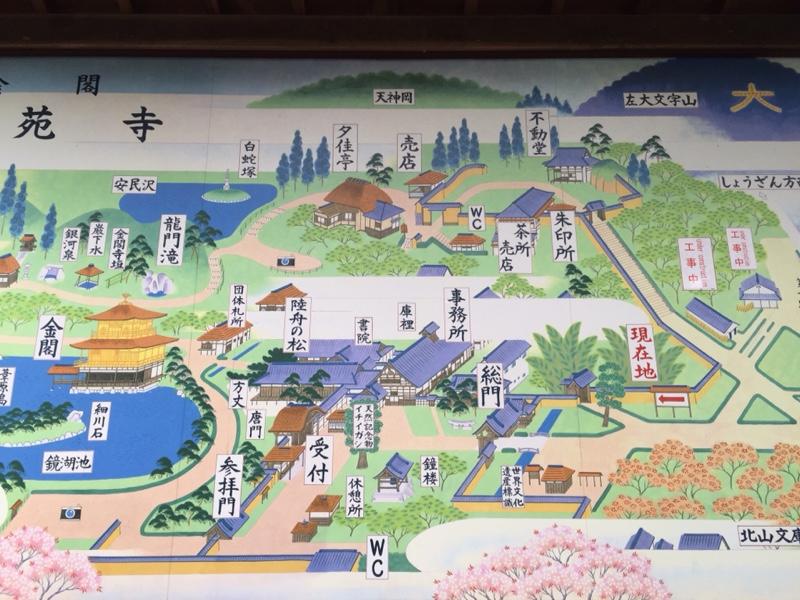
 The doors opened and we were in a group of about 80 early bird tourists to make it in for hopefully unpeopled photographs. We could see the tour groups in buses arriving as we were going in and I can only imagine that it got very packed very quickly. I am unapologetically posting as many photos of this incredible spot as I can.
The doors opened and we were in a group of about 80 early bird tourists to make it in for hopefully unpeopled photographs. We could see the tour groups in buses arriving as we were going in and I can only imagine that it got very packed very quickly. I am unapologetically posting as many photos of this incredible spot as I can. 
 The first level is built in the Shinden style of the 11th C imperial aristocracy, and the second level is built in the Buke style of the warrior aristocracy. The very top level is built in the Chinese Zenshu-Butsuden style, but overall Kinkaku isrepresentative of Muromachi period architecture. All of which is well and good but I read that in 1950 a young monk became obsessed with the temple and his obsession culminated in his burning the place to the ground! So what we are looking at today is a 1955 reconstruction that was completed using the exact original design, but the golden foil covering was extended to cover the lower levels, which the original temple did not have. Obsessed monks indeed…
The first level is built in the Shinden style of the 11th C imperial aristocracy, and the second level is built in the Buke style of the warrior aristocracy. The very top level is built in the Chinese Zenshu-Butsuden style, but overall Kinkaku isrepresentative of Muromachi period architecture. All of which is well and good but I read that in 1950 a young monk became obsessed with the temple and his obsession culminated in his burning the place to the ground! So what we are looking at today is a 1955 reconstruction that was completed using the exact original design, but the golden foil covering was extended to cover the lower levels, which the original temple did not have. Obsessed monks indeed… 
 Oh, and forget yesterday’s Hojo Gardens at Choin-in Temple… these are far and away the most impressive gardens I have ever seen. So immaculately kept and so beautifully laid out. With so many people coming through I can well understand why there are no seats around for people to loiter on, but it would be absolutely amazing to be in here alone under a tree, watching the nearly 50cm long carp and koi plopping in the water occasionally and listening to the breeze in the trees. Just stunningly gorgeous. Makes you wish you had a few hectares at home to make a garden of your own… oh, and the resources to pay the 20 plus gardeners you’d need to keep it looking so lovely and orderly. It has literally just dawned on me why I feel these gardens are so pleasing – they’re orderly. They’re not strategically overgrown English cottage gardens, which have their own appeal in their own right… they’re precise, expertly pruned, well kept and very, very orderly. Which suits my sensibilities perfectly.
Oh, and forget yesterday’s Hojo Gardens at Choin-in Temple… these are far and away the most impressive gardens I have ever seen. So immaculately kept and so beautifully laid out. With so many people coming through I can well understand why there are no seats around for people to loiter on, but it would be absolutely amazing to be in here alone under a tree, watching the nearly 50cm long carp and koi plopping in the water occasionally and listening to the breeze in the trees. Just stunningly gorgeous. Makes you wish you had a few hectares at home to make a garden of your own… oh, and the resources to pay the 20 plus gardeners you’d need to keep it looking so lovely and orderly. It has literally just dawned on me why I feel these gardens are so pleasing – they’re orderly. They’re not strategically overgrown English cottage gardens, which have their own appeal in their own right… they’re precise, expertly pruned, well kept and very, very orderly. Which suits my sensibilities perfectly. 
 Off to the side of the pagoda is a little patio/landing where Sayuri is finally united with the Chairman at the end of the film, ‘Memoirs of a Geisha’… going to have to watch that again and see how much of Kyoto, and Gion in particular, is familiar.
Off to the side of the pagoda is a little patio/landing where Sayuri is finally united with the Chairman at the end of the film, ‘Memoirs of a Geisha’… going to have to watch that again and see how much of Kyoto, and Gion in particular, is familiar. 
 This sign probably says something hideously practical, like, “Tea house This Way”, but with my in-ability to read Japanese and my current effusive state of mind, I am going to choose to think it reads, “Stairway to Heaven” today. Ask me again tomorrow, and it might read, “Please refrain from using these steps, as you can see they are dangerously worn away from hundreds of years of hundreds of feets using them” … yes, all that in just four characters!
This sign probably says something hideously practical, like, “Tea house This Way”, but with my in-ability to read Japanese and my current effusive state of mind, I am going to choose to think it reads, “Stairway to Heaven” today. Ask me again tomorrow, and it might read, “Please refrain from using these steps, as you can see they are dangerously worn away from hundreds of years of hundreds of feets using them” … yes, all that in just four characters! Next thing we saw was the Ryumon Taki, I have no idea what that means, but the tourists have taken it upon themselves to throw coins into the curved stone bowl, and a strategically placed steel bowl that made a satisfying ting as you coin bounced out of it. Of course we all threw a ‘temple coin’ (aka shrappers) into the bowl. Only Mr K got it in one… and he made a wish for good health, because of course we are on the go, go, go which means he’s coming down with something.
Next thing we saw was the Ryumon Taki, I have no idea what that means, but the tourists have taken it upon themselves to throw coins into the curved stone bowl, and a strategically placed steel bowl that made a satisfying ting as you coin bounced out of it. Of course we all threw a ‘temple coin’ (aka shrappers) into the bowl. Only Mr K got it in one… and he made a wish for good health, because of course we are on the go, go, go which means he’s coming down with something. Even gorgeous just peeking through the top of the trees…
Even gorgeous just peeking through the top of the trees… At the Fudo-do shrine, we saw a row of weird little Fortune boxes, and around the corner, English Fortunes, Chinese Fortunes, and Portuguese Fortunes!? Seemed like an opportunity too good to pass up, so we threw in a coin and a genuine ‘Fortune’ came out.
At the Fudo-do shrine, we saw a row of weird little Fortune boxes, and around the corner, English Fortunes, Chinese Fortunes, and Portuguese Fortunes!? Seemed like an opportunity too good to pass up, so we threw in a coin and a genuine ‘Fortune’ came out.
 Et, voila! My fortune… “An unexpected misfortune will happen to you, but you can get over it if you can behave yourself and are prudent.” Well, so much for that… well behaved and prudent. What are the odds?
Et, voila! My fortune… “An unexpected misfortune will happen to you, but you can get over it if you can behave yourself and are prudent.” Well, so much for that… well behaved and prudent. What are the odds? 
 A little baby Shinto shrine, that was around the back of the Fudo-do shrine… I really wish there was ore information on what each of these are for – the complete inability to read anything really makes you feel like you are missing stuff.
A little baby Shinto shrine, that was around the back of the Fudo-do shrine… I really wish there was ore information on what each of these are for – the complete inability to read anything really makes you feel like you are missing stuff.  Mr K contemplating the down hill stairs – there may or may not be a bit of delayed onset muscle pain going on after the Mr Fuji adventure… everyone’s a little sore and double thinking things (the way I do every day, it’s kinda cute).
Mr K contemplating the down hill stairs – there may or may not be a bit of delayed onset muscle pain going on after the Mr Fuji adventure… everyone’s a little sore and double thinking things (the way I do every day, it’s kinda cute).

 After we left Kinkaku-ji, we were heading for the famous Arashiyama bamboo forest – so famous, it graces the cover of the current edition of the Lonely Planet for Japan that nearly everyone we meet is carrying around (as are we).
After we left Kinkaku-ji, we were heading for the famous Arashiyama bamboo forest – so famous, it graces the cover of the current edition of the Lonely Planet for Japan that nearly everyone we meet is carrying around (as are we).
 My compliments and congratulations on their upcoming wedding were well received and they were happy to let me take their photo. The blushing bride looked absolutely perfect – though lord knows how she did, given it was 36C, over 70% humidity and nary a breeze to be hard. She must have been so hot under all that, but she just looked so lovely.
My compliments and congratulations on their upcoming wedding were well received and they were happy to let me take their photo. The blushing bride looked absolutely perfect – though lord knows how she did, given it was 36C, over 70% humidity and nary a breeze to be hard. She must have been so hot under all that, but she just looked so lovely.
 Eventually we wandered back up in the correct direction, via a stop for kiwi fruit ice creams, and found the relative coolness of the bamboo forest… and I mean relative. It was probably still 30C something in there, but at least you could take your hat off for a few moments and try cool off. It’s not quite as picturesque as the pics on the guide book, but was a very pleasant stroll nonetheless. I did wonder though that with the hundreds of people also wandering through the grove (that I worked very hard to try and keep out of my pics), why haven’t the city/council, just planted another five or six more bamboo groves in various areas of town? Curious.
Eventually we wandered back up in the correct direction, via a stop for kiwi fruit ice creams, and found the relative coolness of the bamboo forest… and I mean relative. It was probably still 30C something in there, but at least you could take your hat off for a few moments and try cool off. It’s not quite as picturesque as the pics on the guide book, but was a very pleasant stroll nonetheless. I did wonder though that with the hundreds of people also wandering through the grove (that I worked very hard to try and keep out of my pics), why haven’t the city/council, just planted another five or six more bamboo groves in various areas of town? Curious.
 Some lovely ladies we saw at the train station – apparently it is quite common for tourists to rent a kimono for the day and have their hair done up to tour various sites, and it is very popular with Chinese visitors.
Some lovely ladies we saw at the train station – apparently it is quite common for tourists to rent a kimono for the day and have their hair done up to tour various sites, and it is very popular with Chinese visitors.  After all that – about 5-6 hours wandering around in just draining heat, we came back to Gion and had some quick lunch… followed by a nap for those of us who had completely lost their ability to deal, and The Last Samurai on Blu-Ray for Angel and me. Lunch boxes here are fantastic – so cheap and full of yummy fresh sushi, and available at the 7-11. Wish we could get this sort of thing at home.
After all that – about 5-6 hours wandering around in just draining heat, we came back to Gion and had some quick lunch… followed by a nap for those of us who had completely lost their ability to deal, and The Last Samurai on Blu-Ray for Angel and me. Lunch boxes here are fantastic – so cheap and full of yummy fresh sushi, and available at the 7-11. Wish we could get this sort of thing at home. 
 Escaping from the heat for the afternoon was a good plan, we didn’t head back out until after dark when it was a far more tolerable 26C and still 70% humidity… and only then to go have a quick look around the area at night and try to find some ramen noodles. We found several places open just up the street – it’s weird how many tiny little restaurants there are everywhere here, in amongst the houses and down tiny alleys, great little bars and restaurants that barely seat 10-12 people. We also have vending machines with coffee, soft drinks, water and sports drinks just at the end of the driveway that leads into the apartment, and they seem to be on every other corner. But I digress, we found a great little ramen place about 100m from here (after passing three other restaurants!), and had some delicious traditional (according to the menu ‘traditional 1970s style ramen noodle’… lol) meals. Very quaint little place.
Escaping from the heat for the afternoon was a good plan, we didn’t head back out until after dark when it was a far more tolerable 26C and still 70% humidity… and only then to go have a quick look around the area at night and try to find some ramen noodles. We found several places open just up the street – it’s weird how many tiny little restaurants there are everywhere here, in amongst the houses and down tiny alleys, great little bars and restaurants that barely seat 10-12 people. We also have vending machines with coffee, soft drinks, water and sports drinks just at the end of the driveway that leads into the apartment, and they seem to be on every other corner. But I digress, we found a great little ramen place about 100m from here (after passing three other restaurants!), and had some delicious traditional (according to the menu ‘traditional 1970s style ramen noodle’… lol) meals. Very quaint little place. 


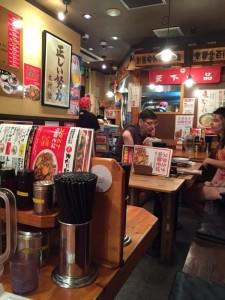





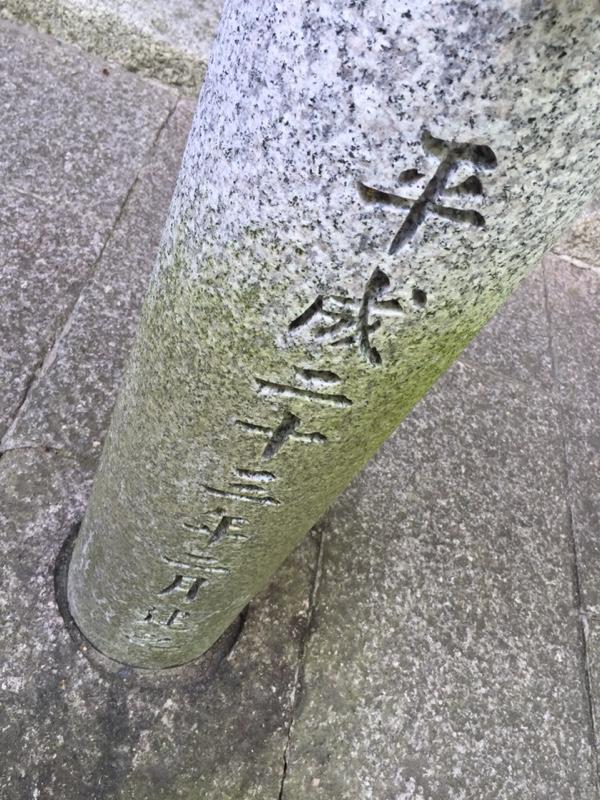
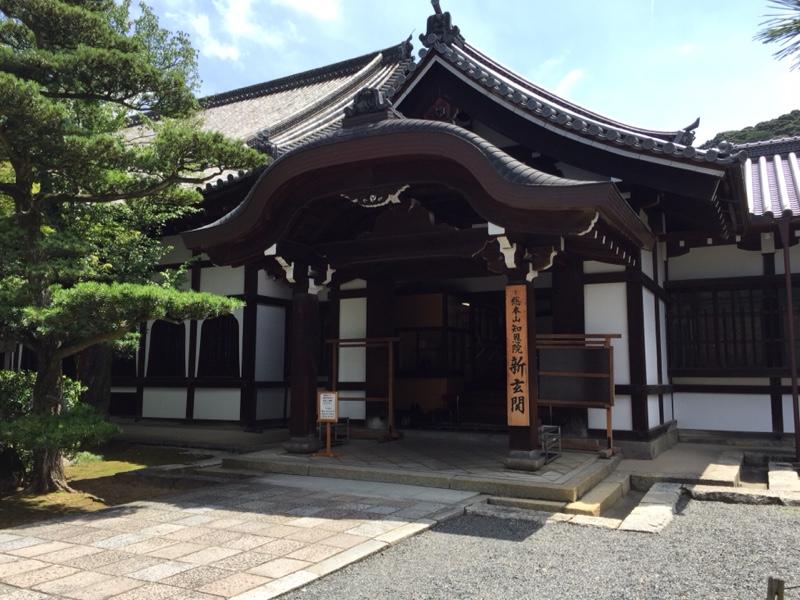






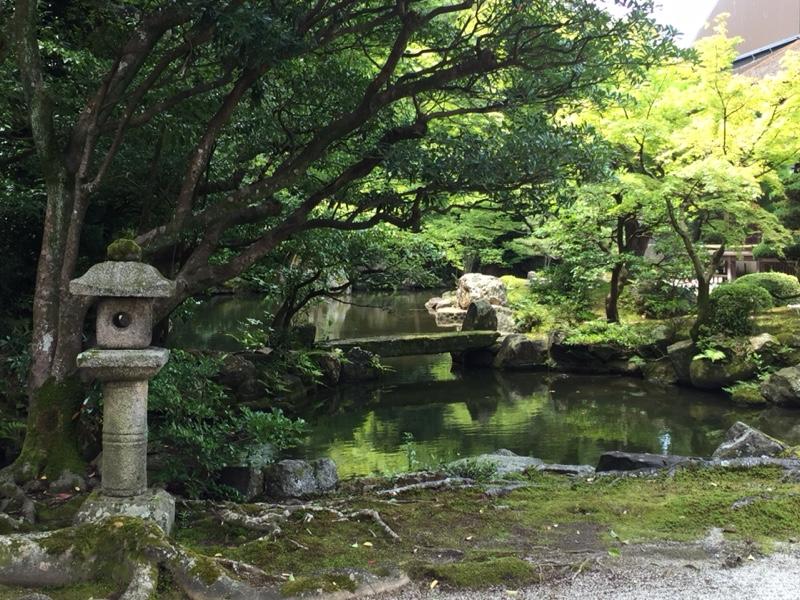



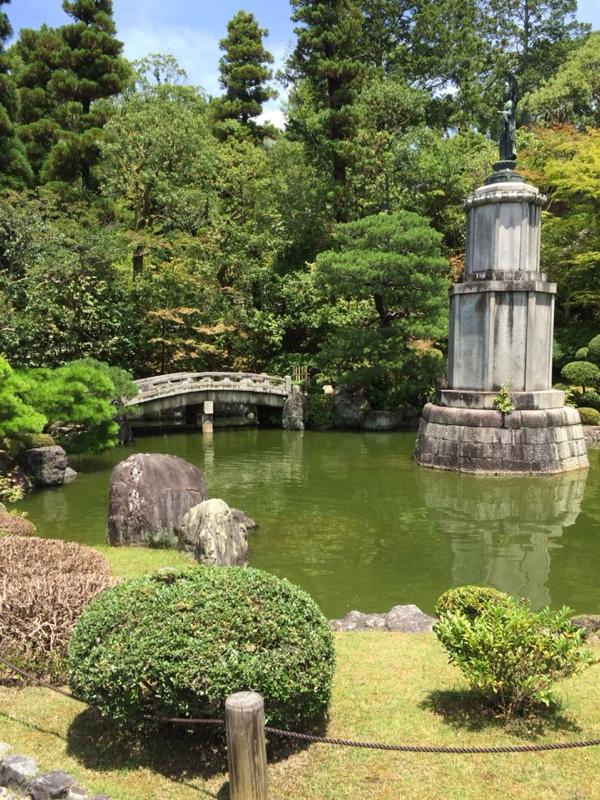

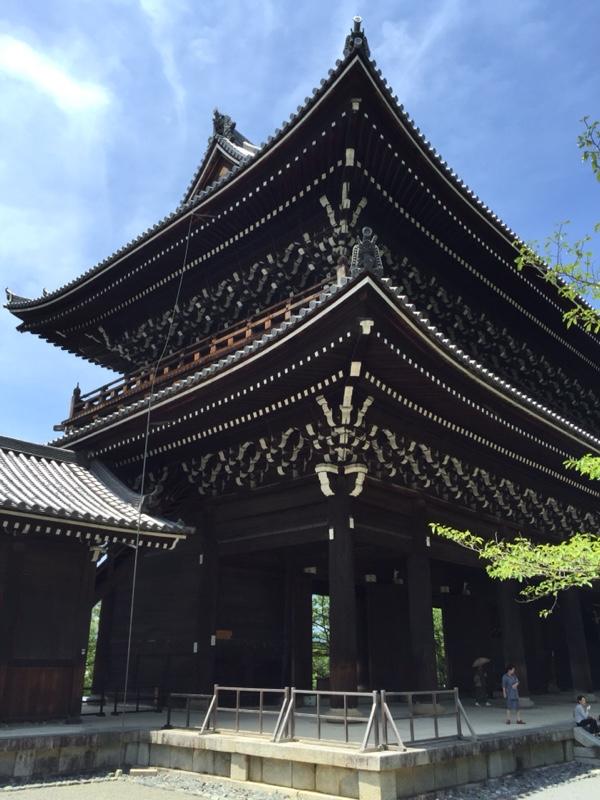















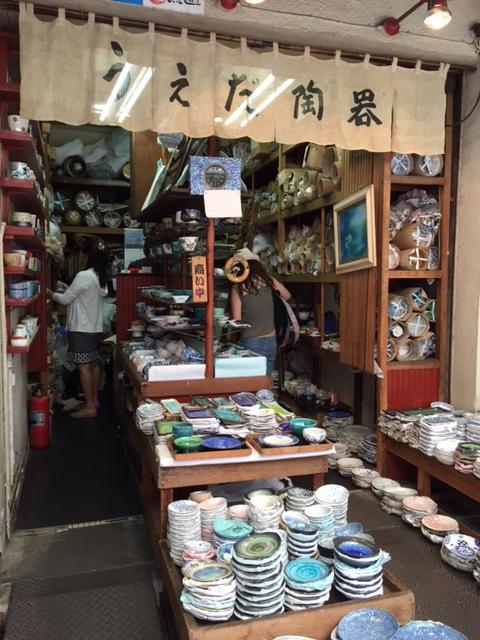












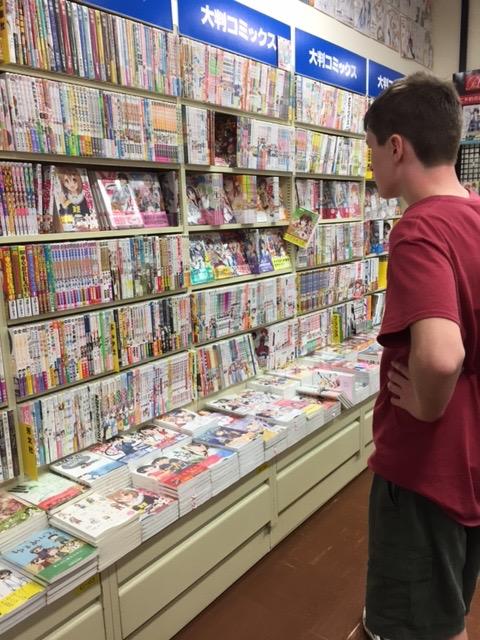




 We started off at 2pm, much later than planned, and while we had full tummies we were walking through a cold, fine mist of fog. At some point the track splits out for different hikes, and we saw the first sign to the Fuji summit and began climbing back up. We were still in a semi-forested area, where new trees were growing out of the ground and then appeared to be growing straight sideways. There was lots of water on the ground, so the track was wet, as it had been raining for weeks apparently.
We started off at 2pm, much later than planned, and while we had full tummies we were walking through a cold, fine mist of fog. At some point the track splits out for different hikes, and we saw the first sign to the Fuji summit and began climbing back up. We were still in a semi-forested area, where new trees were growing out of the ground and then appeared to be growing straight sideways. There was lots of water on the ground, so the track was wet, as it had been raining for weeks apparently.
















